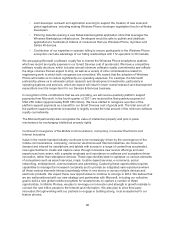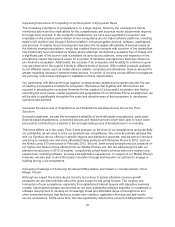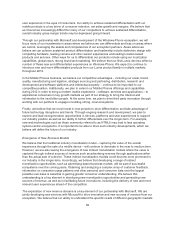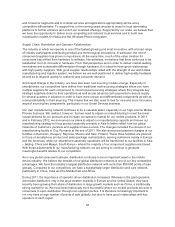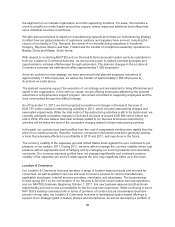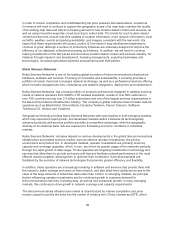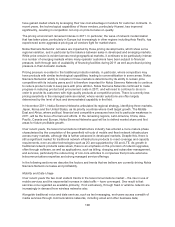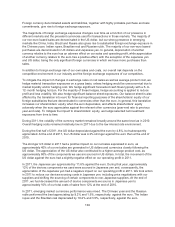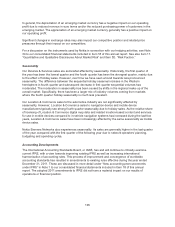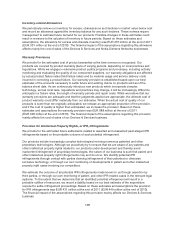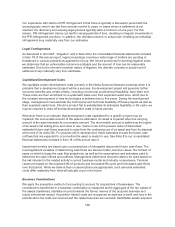Nokia 2011 Annual Report Download - page 101
Download and view the complete annual report
Please find page 101 of the 2011 Nokia annual report below. You can navigate through the pages in the report by either clicking on the pages listed below, or by using the keyword search tool below to find specific information within the annual report.In order to remain competitive and notwithstanding the price pressure discussed above, Location &
Commerce will need to continue to expand the geographic scope of its map data, maintain the quality
of its existing map data and add an increasing amount of new location-based content and services, as
well as using innovative ways like crowd sourcing to collect data. The trends for such location-based
content and services include real-time updates to location information, more dynamic information, such
as traffic, weather, events and parking availability, and imagery consistent with the real world. We
expect that these requirements will cause Location & Commerce’s map development expenses to
continue to grow, although a number of productivity initiatives are underway designed to improve the
efficiency of our database collection processing and delivery. In addition, we will need to continue
making investments in this fast paced and innovative location-based content and services industry, for
instance through research and development, licensing arrangements, acquiring businesses and
technologies, recruiting specialized expertise and partnering with third parties.
Nokia Siemens Networks
Nokia Siemens Networks is one of the leading global providers of telecommunications infrastructure
hardware, software and services. Focusing on innovation and sustainability, it currently provides a
portfolio of mobile, fixed and converged network technology, as well as a professional services offering
which includes managed services, consultancy and systems integration, deployment and maintenance.
Nokia Siemens Networks’ has a broad portfolio of products and services designed to address evolving
needs of network operators from GSM to LTE wireless standards, a base of over 600 customers in
over 150 countries serving over 2.5 billion subscribers and one of the largest services organizations in
the telecommunications infrastructure industry. The company’s global customer base includes network
operators such as Bharti Airtel, China Mobile, Deutsche Telekom, France Telecom, Softbank,
Telefonica O2, Verizon and Vodafone.
Geographical diversity provides Nokia Siemens Networks with opportunities in both emerging markets,
which may experience rapid growth, and developed markets where it believes its technologically
advanced products and services portfolio provides a competitive advantage, while the geographic
diversity of its customer base reduces exposure to fluctuating economic conditions in individual
markets.
Nokia Siemens Networks’ net sales depend on various developments in the global telecommunications
infrastructure and related services market, such as network operator investments, the pricing
environment and product mix. In developed markets, operator investments are primarily driven by
capacity and coverage upgrades, which, in turn, are driven by greater usage of the networks primarily
through the rapid growth in data usage. Those operators are targeting investments in technology and
services that allow them to provide end users with fast and faultless network performance in the most
efficient manner possible, allowing them to optimize their investment. Such developments are
facilitated by the evolution of network technologies that promote greater efficiency and flexibility.
In addition, those operators are increasingly investing in software and services that provide them with
the means to better manage end users on their network, and also allow them additional access to the
value of the large amounts of subscriber data under their control. In emerging markets, the principal
factors influencing operator investments are the continued growth in customer demand for
telecommunications services, including data, as well as new subscriber growth. In many emerging
markets, this continues to drive growth in network coverage and capacity requirements.
The telecommunications infrastructure market is characterized by intense competition and price
erosion caused in part by the entry into the market of vendors from China, Huawei and ZTE, which
99



